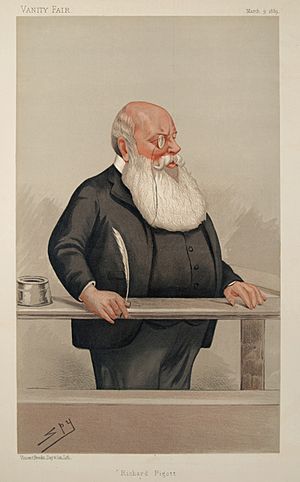Richard Pigott facts for kids
Quick facts for kids
Richard Pigott
|
|
|---|---|

Pigott as caricatured by Spy (Leslie Ward) in Vanity Fair, March 1889
|
|
| Born | 1835 Ratoath, County Meath, Ireland
|
| Died | 1 March 1889 (aged 53–54) Madrid, Spain
|
| Occupation | Journalist |
| Known for | The 'Pigott Papers' forgery |
Richard Pigott (born 1835 – died 1 March 1889) was an Irish journalist. He is mostly known for creating fake letters. These letters wrongly suggested that a famous Irish leader, Charles Stewart Parnell, supported some serious crimes. This event became a big scandal in Irish and British politics.
Contents
Richard Pigott: A Journalist's Story
Richard Pigott was born in Ratoath, County Meath, Ireland, in 1835. When he was a young man, he supported Irish nationalism. This was a movement that wanted more independence for Ireland. He worked for newspapers like The Nation and The Tablet. Later, he managed a newspaper called The Irishman.
Pigott also worked for the Irish National Land League. This group helped Irish farmers. In 1883, Pigott left the League. He made accusations about how the League's money was handled. After this, Pigott turned against the League. The League was connected to the Irish Parliamentary Party, led by Charles Stewart Parnell.
The Fake Letters Scandal
In 1879, Pigott owned three newspapers. He soon sold them to the Land League. After 1884, Pigott started to speak badly about his former friends. He sold information to people who were against them.
To try and ruin Parnell's career, Pigott created several fake letters. These letters falsely claimed that Parnell had supported the people who carried out the Phoenix Park murders in 1882. These murders were a very serious event where two important British officials were killed in Dublin.
The Truth Comes Out
A famous newspaper called The Times bought Pigott's fake letters. They paid a lot of money for them. On 18 April 1887, The Times published the most damaging letter. Parnell immediately said it was "a villainous and barefaced forgery."
In February 1889, a special investigation called the Parnell Commission proved Parnell was right. They showed that the letters were fake. The letters even had misspellings that Pigott was known to make. Parnell was cleared of all accusations. His political career was saved.
What Happened Next?
After admitting he made the fake letters, Pigott ran away to Spain. He later died in a hotel room in Madrid.
Parnell then sued The Times newspaper for publishing the fake letters. The newspaper paid Parnell a large sum of money to settle the case outside of court. When Parnell returned to the British House of Commons, his fellow politicians welcomed him like a hero.

